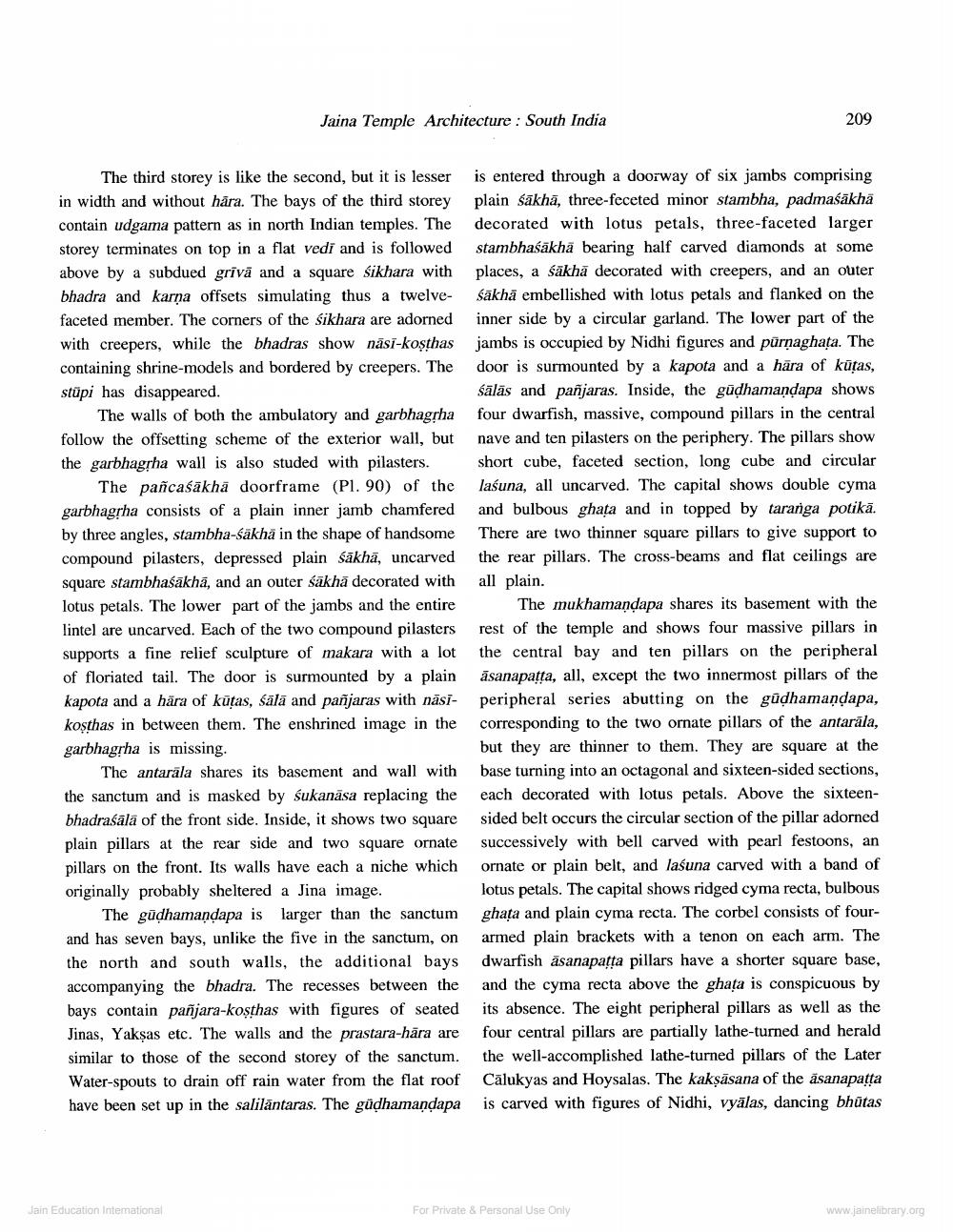________________
Jaina Temple Architecture : South India
209
The third storey is like the second, but it is lesser in width and without hāra. The bays of the third storey contain udgama pattern as in north Indian temples. The storey terminates on top in a flat vedi and is followed above by a subdued griva and a square sikhara with bhadra and karņa offsets simulating thus a twelve- faceted member. The corners of the sikhara are adorned with creepers, while the bhadras show nāsi-koşthas containing shrine-models and bordered by creepers. The stūpi has disappeared.
The walls of both the ambulatory and garbhagrha follow the offsetting scheme of the exterior wall, but the garbhagțha wall is also studed with pilasters.
The pañcaśäkhá doorframe (Pl. 90) of the garbhagrha consists of a plain inner jamb chamfered by three angles, stambha-sakha in the shape of handsome compound pilasters, depressed plain sākhā, uncarved square stambhasakha, and an outer sakha decorated with lotus petals. The lower part of the jambs and the entire lintel are uncarved. Each of the two compound pilasters supports a fine relief sculpture of makara with a lot of floriated tail. The door is surmounted by a plain kapota and a hära of kūtas, sālā and pañjaras with nāsi- koşthas in between them. The enshrined image in the garbhagrha is missing.
The antarala shares its basement and wall with the sanctum and is masked by śukanāsa replacing the bhadraśālā of the front side. Inside, it shows two square plain pillars at the rear side and two square ornate pillars on the front. Its walls have each a niche which originally probably sheltered a Jina image.
The gūdhamandapa is larger than the sanctum and has seven bays, unlike the five in the sanctum, on the north and south walls, the additional bays accompanying the bhadra. The recesses between the bays contain panjara-kosthas with figures of seated Jinas, Yakşas etc. The walls and the prastara-hāra are similar to those of the second storey of the sanctum. Water-spouts to drain off rain water from the flat roof have been set up in the saliläntaras. The güdhamandapa
is entered through a doorway of six jambs comprising plain sākhā, three-feceted minor stambha, padmaśākha decorated with lotus petals, three-faceted larger stambhaśākha bearing half carved diamonds at some places, a säkhă decorated with creepers, and an outer sākhā embellished with lotus petals and flanked on the inner side by a circular garland. The lower part of the jambs is occupied by Nidhi figures and purnaghata. The door is surmounted by a kapota and a hāra of kūtas, śālās and pañjaras. Inside, the gūdhamandapa shows four dwarfish, massive, compound pillars in the central nave and ten pilasters on the periphery. The pillars show short cube, faceted section, long cube and circular lasuna, all uncarved. The capital shows double cyma and bulbous ghata and in topped by taranga potikā. There are two thinner square pillars to give support to the rear pillars. The cross-beams and flat ceilings are all plain.
The mukhamandapa shares its basement with the rest of the temple and shows four massive pillars in the central bay and ten pillars on the peripheral asanapatta, all, except the two innermost pillars of the peripheral series abutting on the gūdhamandapa, corresponding to the two ornate pillars of the antarāla, but they are thinner to them. They are square at the base turning into an octagonal and sixteen-sided sections, each decorated with lotus petals. Above the sixteensided belt occurs the circular section of the pillar adorned successively with bell carved with pearl festoons, an ornate or plain belt, and lasuna carved with a band of lotus petals. The capital shows ridged cyma recta, bulbous ghata and plain cyma recta. The corbel consists of fourarmed plain brackets with a tenon on each arm. The dwarfish asanapata pillars have a shorter square base, and the cyma recta above the ghata is conspicuous by its absence. The eight peripheral pillars as well as the four central pillars are partially lathe-turned and herald the well-accomplished lathe-turned pillars of the Later Cālukyas and Hoysalas. The kakṣāsana of the asanapatta is carved with figures of Nidhi, vyālas, dancing bhūtas
Jain Education Intemational
ation Intermational
For Private & Personal Use Only
For Private & Personal Use Only
www.jainelibrary.org




